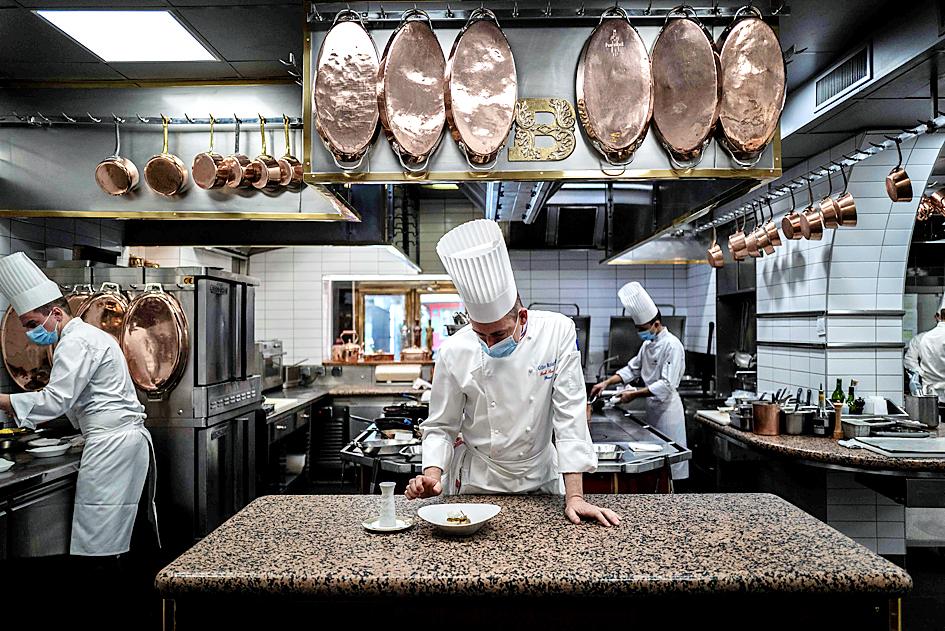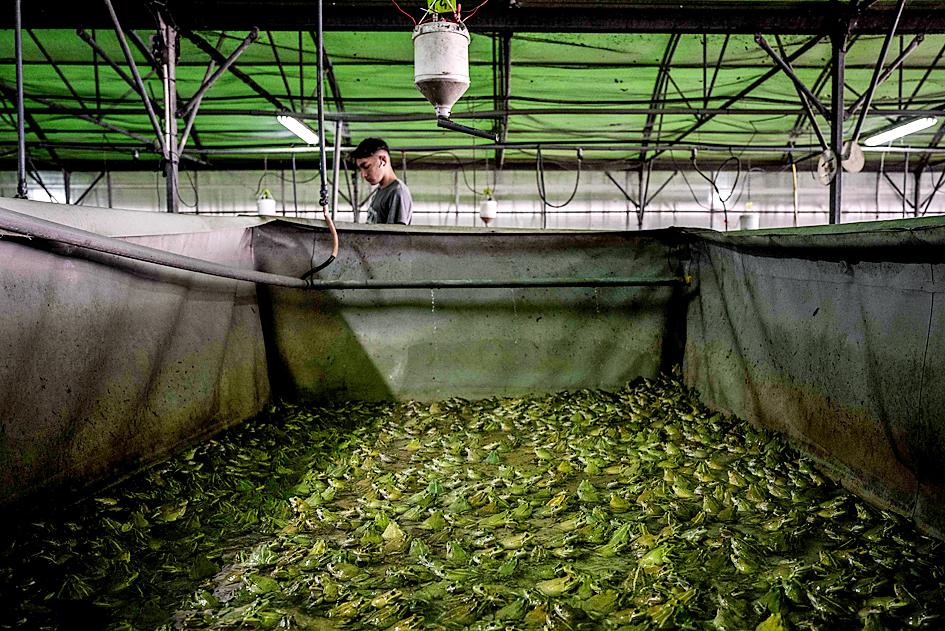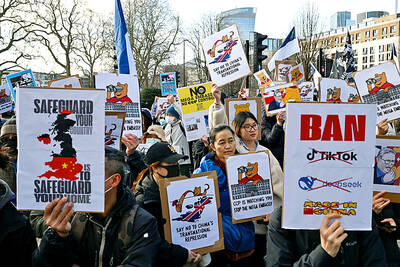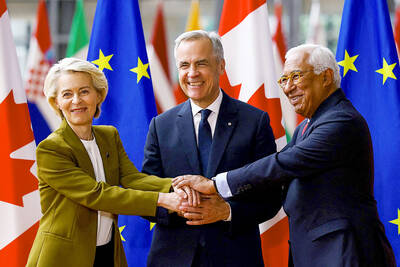Every year, the French consume about 4,000 tonnes of frog legs — the equivalent of 40 blue whales — but nearly all of the amphibian limbs that land on French plates come from abroad, as wild harvesting of the protected creatures is all but banned and their cultivation strictly controlled.
One of France’s handful of frog farmers, Patrice Francois, provides cuisses de grenouille to the kitchens of Michelin-starred restaurants and neighborhood bistros alike.
Yet, the 100,000 animals being raised at his greenhouses in Pierrelatte in southeast France hardly make a dent in the demand for a delicacy that helped earn the French the nickname “frogs,” at least in the English-speaking world.

Photo: AFP
“Raising frogs is hard,” Francois told reporters, amid a deafening chorus of croaks coming from dozens of “ponds” teeming with marsh frogs, his farm’s specialty.
“It is starting to work out, but I am not yet making a living from it,” said the 56-year-old, who started France’s first frog farm 10 years ago.
To make ends meet, he also sells fish in Roanne, about 230km north.

Photo: AFP
From the incubation of the eggs through raising the tadpoles and fattening up the adults, it takes about one year to produce a frog weighing 50g to 100g, each yielding two hind legs much smaller than chicken thighs.
“We control the entire production chain, from breeding to slaughter after anesthesia by cold, then butchery and shipping,” Francois said.
However, there are many hurdles along the way.
For mating to happen, conditions have to be just right, with the weather and even the lunar cycle affecting the creatures’ amorous moods.
Each fertilization by a male frog of a female’s deposited eggs can have a success rate of zero to 100 percent, depending on conditions, Francois said.
For 1 million eggs produced on the farm, about 100,000, or 10 percent, eventually mature into frogs.
The animals are easily stressed — which is harmful to their health and growth — and can suffocate if too many are grouped together.
The frogs must be grouped by size to prevent the larger ones from cannibalizing the smaller ones.
Five farms in France produce about 10 tonnes of frog meat per year, the French Ministry of Agriculture said, an amount that could reach 20 or even 50 tonnes as soon as this year.
Frogs have been eaten in France for centuries, particularly in the country’s east, but have been a protected species since 2007, because of rapidly declining numbers.
Only small wild harvests for domestic consumption are allowed, with large fines for anyone trying to catch them for sale.
Ninety-nine percent of frogs consumed in the country come from abroad — shipped alive or refrigerated from Albania, Turkey, Bulgaria, Egypt, Belgium and Italy, while frozen ones are shipped by Indonesia, Vietnam and India, the ministry said.
Frogs are also eaten in other European countries such as Belgium, in the southern US and in parts of Asia.
A 2010 study showed that global consumption was 800 million to 3.2 billion frogs, with the US and the EU the largest importers, and Indonesia and China the main exporters.
Conservationists have said that that many frog species are at risk of extinction, driven in large part by human appetites.
In key exporter Turkey, harvested species might become extinct by 2032, a study published this year by Cambridge University Press said.
Among Francois’ top clients is the storied two-Michelin-starred Paul Bocuse restaurant, near Lyon in eastern France, which boasts frog legs on its autumn menu.
Chef Gilles Reinhardt said that the restaurant long had no choice but to rely on imports.
“But nothing beats these ultra-fresh French frogs. The clients love them,” he said. “The meat is much more delicate, the frogs fleshier and firmer ... while still tender.”

‘SHORTSIGHTED’: Using aid as leverage is punitive, would not be regarded well among Pacific Island nations and would further open the door for China, an academic said New Zealand has suspended millions of dollars in budget funding to the Cook Islands, it said yesterday, as the relationship between the two constitutionally linked countries continues to deteriorate amid the island group’s deepening ties with China. A spokesperson for New Zealand Minister of Foreign Affairs Winston Peters said in a statement that New Zealand early this month decided to suspend payment of NZ$18.2 million (US$11 million) in core sector support funding for this year and next year as it “relies on a high trust bilateral relationship.” New Zealand and Australia have become increasingly cautious about China’s growing presence in the Pacific

The team behind the long-awaited Vera Rubin Observatory in Chile yesterday published their first images, revealing breathtaking views of star-forming regions as well as distant galaxies. More than two decades in the making, the giant US-funded telescope sits perched at the summit of Cerro Pachon in central Chile, where dark skies and dry air provide ideal conditions for observing the cosmos. One of the debut images is a composite of 678 exposures taken over just seven hours, capturing the Trifid Nebula and the Lagoon Nebula — both several thousand light-years from Earth — glowing in vivid pinks against orange-red backdrops. The new image

ESPIONAGE: The British government’s decision on the proposed embassy hinges on the security of underground data cables, a former diplomat has said A US intervention over China’s proposed new embassy in London has thrown a potential resolution “up in the air,” campaigners have said, amid concerns over the site’s proximity to a sensitive hub of critical communication cables. The furor over a new “super-embassy” on the edge of London’s financial district was reignited last week when the White House said it was “deeply concerned” over potential Chinese access to “the sensitive communications of one of our closest allies.” The Dutch parliament has also raised concerns about Beijing’s ideal location of Royal Mint Court, on the edge of the City of London, which has so

Canada and the EU on Monday signed a defense and security pact as the transatlantic partners seek to better confront Russia, with worries over Washington’s reliability under US President Donald Trump. The deal was announced after a summit in Brussels between Canadian Prime Minister Mark Carney and European Commission President Ursula von der Leyen and European Council President Antonio Costa. “While NATO remains the cornerstone of our collective defense, this partnership will allow us to strengthen our preparedness ... to invest more and to invest smarter,” Costa told a news conference. “It opens new opportunities for companies on both sides of the